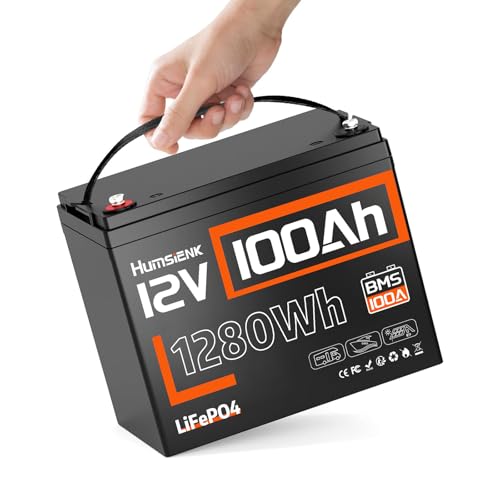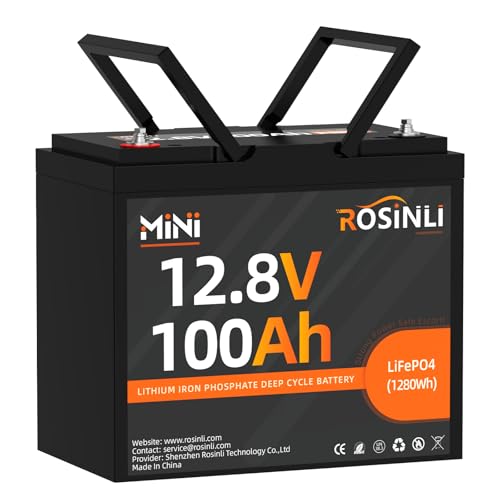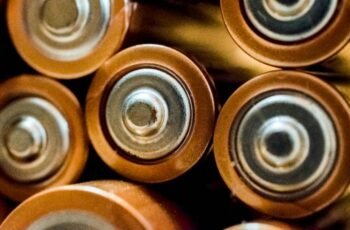Choosing the right LiFePO4 battery can make or break our power setup, whether we’re running an RV, a boat, or a small off-grid system. This year’s standouts bring solid BMS protection, long cycle life, and flexible 12V-to-48V configurations. We’ll highlight compact minis, rugged Group 24/31 options, and a high-capacity 320Ah pick with Bluetooth. We’ll also cover key buying factors like charge methods and scalability—so we don’t risk undersizing or overspending.
Key Takeaways
- 12V 100Ah LiFePO4 (Group 24) delivers ~1,280Wh, 100A BMS, IP67, fast 2-hour charge, and scalable 4S4P to 48V/20.48kWh for RVs and boats.
- Redodo 12V 100Ah offers 12.8V nominal, 100A BMS, 4000–15000 cycles, Group 31 size, and 4S/4P expansion; ideal for RVers and off-grid cabins.
- 12V 100Ah Mini LiFePO4 packs true 100Ah in a 20.9 lb, smaller-than-Group-24 case with BMS; supports 4S/4P and versatile 14.6V charging.
- WEIZE 12V 100Ah Mini provides 1,280Wh in a compact 21.8 lb design, >2,000 cycles at 100% DoD, 100A smart BMS, and any-orientation mounting.
- CHINS 12V 320Ah Bluetooth features 200A BMS, app monitoring, 6000+ cycles, 4S/4P scalability to 48V/1280Ah, and fast solar charging for large builds.
12V 100Ah LiFePO4 Deep Cycle Battery with Built-in BMS (Group 24)
November 19, 2025 8:52 pm
If you need a compact, trail-ready battery that won’t quit, the V 12V 100Ah LiFePO4 (Group 24) stands out with 15,000+ deep cycles, a built‑in 100A BMS, and IP67 waterproofing. We get 1280Wh of usable energy, 6x the lifespan of lead-acid, and reliable performance from -4°F to 158°F. At 23.2 lbs in a Group 24-31 box (8.2 x 6.6 x 10.2 in), it’s lighter and smaller, with nylon handles for easy carry.
It’s safe and certified (SDS/UN38.3/FCC/CE/ROHS), shock resistant, and laboratory tested 999 times. We can expand to 48V/20.48 kWh, charge in ~2 hours, and power RV, marine, and off-grid systems.
Best For: RVers, boaters, and off‑grid users who need a compact, lightweight, long‑lifespan 12V battery with fast charging, rugged IP67 protection, and modular expandability up to 48V systems.
Pros:
- 15,000+ deep cycles and 10-year lifespan; far outlasts lead-acid while delivering 1280Wh usable energy
- Built-in 100A BMS with comprehensive protections (temp, over/under voltage, short, over-current) and IP67 waterproof/shock resistance
- Fast charging (~2 hours) and scalable: up to 4S4P (48V, 20.48 kWh) for RV, marine, and off-grid setups
Cons:
- Low-temperature cutoff below -4°F prevents operation in extreme cold without heating solutions
- 100A continuous BMS may limit very high current applications or large trolling motors requiring higher surge
- Requires compatible LiFePO4 chargers/settings; not a drop-in for all legacy lead-acid charging systems
Redodo 12V 100Ah LiFePO4 Rechargeable Battery with 100A BMS
November 19, 2025 10:14 pm
Meet the Redodo 12V 100Ah LiFePO4—a lightweight, 25.4-pound workhorse with a built-in 100A BMS that’s ideal for RVers, off-grid cabins, and anglers who need dependable, expandable power. We get 12.8V nominal, M8 terminals, and a compact 6.77D x 13W x 8.43H inches that fits Group 31 boxes. It delivers 4000–15000 cycles (depending on depth of discharge), a 10-year lifespan, and about 3% self-discharge.
We can wire up to 4S or 4P for 48V or 400Ah. The BMS guards against overcharge, over-discharge, over-current, shorts, and heat. Charge via 14.6V LiFePO4 charger, solar, alternator, or generator. Great for 30–70 lb thrust trolling motors; not for starting.
Best For: RVers, off‑grid homeowners, and anglers who need a lightweight, expandable 12V power source with long cycle life and reliable 100A BMS protection.
Pros:
- Long lifespan with 4000–15000 cycles and ~3% self-discharge for low maintenance
- Lightweight (25.4 lb) Group 31 form factor with high energy density and easy installation
- Flexible system design: built-in 100A BMS, supports up to 4S/4P, multiple charging methods (14.6V charger, solar, alternator, generator)
Cons:
- Not suitable as a starter or golf cart battery
- Requires LiFePO4-specific charging profile (14.6V) for optimal performance
- Some systems may need attention to inverter grounding and integration details
12V 100Ah Mini LiFePO4 Battery with Built-in BMS
November 19, 2025 4:07 pm
Looking for a compact 12V battery that still delivers real 100Ah capacity? We like this 100Ah Mini LiFePO4 for tight installs—smaller than Group 24, 20.9 lbs, and built with automotive-grade cells for stable power. Its upgraded smart BMS protects against over-charge, over-discharge, over-current, and short-circuit.
Use it for energy storage, not engine starting. It’s great in solar, RVs, camping, trolling motors, off-grid, marine, and home systems. Run up to 4 in series (48V) or 4 in parallel (400Ah). Charge with a 14.6V LiFePO4 charger (20A recommended), solar with controller, or alternator. Certifications include CE, FCC, UN38.3, ROHS, PSE. Backed by a 5-year warranty and responsive support.
Best For: RVers, boaters, and off-grid users who need a compact, lightweight 12V battery with true 100Ah capacity for energy storage (not engine starting).
Pros:
- Smaller than Group 24 and only 20.9 lbs; high energy density from automotive-grade LiFePO4 cells
- Built-in smart BMS (over-charge, over-discharge, over-current, short-circuit) and supports 4S/4P scaling up to 48V or 400Ah
- Multiple charging options (14.6V LiFePO4 charger recommended, solar with controller, alternator) and 5-year warranty
Cons:
- Not suitable for engine starting; energy storage use only
- Requires proper LiFePO4 charging profile (14.6V); may need new charger or controller
- Mixed user reports on warranty/service experiences despite generally positive performance reviews
WEIZE 12V 100Ah Mini LiFePO4 Battery with Built-in 100A BMS
November 19, 2025 10:14 pm
Compact power stands out here: WEIZE’s 12V 100Ah Mini LiFePO4 packs 1,280Wh with a built‑in 100A smart BMS in a case that’s 25% smaller and just 21.8 pounds. We like its compact 6.61 x 10.24 x 8.27-inch footprint for RVs, solar banks, marine, trolling motors, and backup sump pumps. Expect >2,000 cycles at 100% DoD, or about 8,000 at 50%—a major upgrade over lead-acid. The automatic BMS handles over/under-voltage, overcurrent, short circuit, and low/high temps, plus cold-weather protection.
It’s maintenance-free, safe, and mountable in any orientation. Note: energy storage only—not for starting engines. Charger compatibility and BMS wake behavior can vary.
Best For: RV owners, off-grid solar users, boaters, and anglers who need a compact, lightweight 12V 100Ah LiFePO4 battery for reliable deep-cycle energy storage (not engine starting).
Pros:
- 25% smaller and only 21.8 lb while delivering 1,280Wh; ideal for tight spaces and weight-sensitive setups
- Long lifespan: >2,000 cycles at 100% DoD or ~8,000 at 50% DoD, with maintenance-free operation
- Built-in 100A smart BMS with protections (over/under-voltage, overcurrent, short circuit, temp) and cold-weather protection
Cons:
- Not suitable for engine starting or golf carts; energy storage only
- Charger compatibility and BMS wake/sleep behavior can vary by setup
- Higher upfront cost than lead-acid despite lower lifetime cost
CHINS 12V 320Ah Bluetooth LiFePO4 Battery with 200A BMS
November 18, 2025 10:37 pm
Serious off‑grid builders and RVers who want real-time control will gravitate to the CHINS 12V 320Ah Bluetooth LiFePO4 with its 200A BMS and app-based monitoring. We get 6000+ cycles—8–10x lead‑acid—plus a pack that’s about 30% lighter, maintenance‑free, and low self‑discharge. The Bluetooth app (5–10m range) shows voltage, current, and state of charge, replacing separate gauges for RVs, solar cabins, and home backup.
The 200A BMS protects against over/under‑voltage, shorts, and temps above 122°F. Scale to 48V or 1280Ah (4S/4P) using identical CHINS purchased within six months. Expect fast charging—about 8 hours via 600W solar—and 200A continuous output for up to 2560W loads.
Best For: Off-grid builders, RVers, and marine users who want long-life LiFePO4 storage with real-time Bluetooth monitoring, robust 200A output, and easy expansion to higher voltage or capacity.
Pros:
- 6000+ cycles and ~30% lighter than lead-acid; maintenance-free with low self-discharge
- Built-in Bluetooth app (5–10m) shows voltage, current, and SOC—reduces need for separate gauges
- 200A BMS allows 200A continuous (up to 2560W) with strong protections and scalable 4S/4P configurations
Cons:
- Bluetooth range is short (5–10m), limiting remote monitoring distance
- Must use identical CHINS batteries purchased within 6 months for series/parallel expansion
- Charging still takes hours (e.g., ~8 hrs with 600W solar, ~17 hrs with 20A charger) compared to higher-current systems
Factors to Consider When Choosing Deep Cycle LiFePO4 Batteries
As we choose a deep-cycle LiFePO4 battery, we should match capacity and voltage to our load, confirm a long cycle life rating, and insist on a robust Battery Management System. We’ll also check the operating temperature range to ensure reliable performance in our climate. Finally, we’ll consider size and weight to fit our space and mobility needs.
Capacity and Voltage
Wondering how to size a LiFePO4 battery for your setup? We start with capacity: amp-hours (Ah) tell us how long a battery can run a given load. Higher Ah means more stored energy. Convert to watt-hours (Wh) for easier planning: Wh = voltage × Ah. For example, a “12V” 100Ah LiFePO4 holds about 1,280Wh (12.8V × 100Ah).
Voltage matters for system design. A single 12V LiFePO4 sits around 12.8V nominal, charges up to ~14.6V, and keeps a near-flat voltage under load. Need higher system voltage? Wire in series to increase voltage (e.g., four in series reach ~51.2V). Need more runtime? Wire in parallel to add Ah. Mix both (e.g., 4S4P) for voltage and capacity. Size for your typical depth of discharge to preserve usable capacity.
Cycle Life Rating
How long will a LiFePO4 pack really last? Cycle life rating tells us, expressing how many full depth-of-discharge (DoD) cycles a battery can deliver before capacity drops to a defined endpoint, typically 80%—sometimes 70%—of its original. LiFePO4 beats lead-acid here, with credible claims spanning roughly 1,000 to 15,000 cycles, depending on DoD and operating conditions.
We should pay close attention to the DoD used for the rating. Higher DoD shortens life, so a pack rated at 80% DoD generally outlasts one cycled at 100% DoD. Manufacturers often publish curves or tables at 100%, 80%, and 60% DoD, letting us estimate real-world longevity based on how deep we plan to discharge.
Expect longer cycle life to cost more upfront, but deliver lower lifetime cost per cycle.
Battery Management System
Cycle life only pays off if a pack stays protected, and that’s the Battery Management System’s job. We look for a BMS that guards against overcharge, over‑discharge, over‑current, short circuits, and high temperature to prevent cell damage and safety issues. For 12V packs, a 100A–200A BMS rating suits most inverters and motors, capping discharge and peak surges; many units auto‑disconnect if current spikes near 300±50A.
We also value low‑temperature cutoffs that block unsafe charging or discharging down to specified minimums, plus multi‑point protection for clean series/parallel builds (up to 4S/4P or 48V) with balanced cells and minimal voltage sag. Finally, integrated monitoring—Bluetooth or onboard displays—lets us track voltage, current, and state of charge in real time for smarter system management.
Operating Temperature Range
Temperature swings can make or break a LiFePO4 setup, so we weigh operating range as heavily as capacity. Most deep-cycle LiFePO4 batteries discharge safely down to about -4°F (-20°C), but charging typically shouldn’t start below roughly 14°F (-10°C). In cold weather, expect reduced effective capacity and shorter runtime; in heat, cells can degrade faster if thermal management is lacking.
We look for a robust BMS with low/high temperature protection that can pause or limit charge and discharge when conditions drift out of spec. Manufacturers often rate operation from about -4°F to 140°F (-20°C to 60°C); staying within that ambient range supports cycle life. For outdoor or off-grid installs, we prioritize thermo-safety features and smart enclosure placement to keep temperatures stable.
Size and Weight
While smart thermal limits keep cells healthy, the battery’s footprint and mass decide where and how we can install it. LiFePO4 deep-cycle options typically weigh far less than lead-acid, often around 20–25 pounds for a 100Ah unit, slashing total system weight in RVs, boats, and off-grid rigs. Their compact form factors—roughly 8–9 inches deep and 6–10 inches wide—fit tight cabinets and marine compartments without reworking layouts.
Higher energy density, around 58 Wh per pound for some models, delivers more usable capacity in a smaller package. That smaller size also makes scaling straightforward: we can build up to 4S or 4P banks to hit target voltage and capacity without growing the footprint. Integrated BMS and robust casings support outdoor and mobile installs while preserving compact dimensions.
Charge/Discharge Rates
How fast can we safely push power in and out of a LiFePO4? It depends on the BMS and cell chemistry. Most packs support 0.5C–1C charging and 1C–2C discharging, if designed for it. For a 100Ah battery, that’s roughly a 50–100A charge—about 1–2 hours with the right charger—versus the 14+ hours common with lead-acid. Many systems also publish maximum continuous discharge (e.g., 100A or 200A) and auto‑disconnect thresholds to prevent over‑discharge.
We should match C‑rates to our use case. Higher rates raise heat, trim effective capacity, and can shorten cycle life without good cooling and well‑balanced cells. In multi‑battery banks (series or parallel, such as 4S4P or up to 48V), total current handling changes, so we’ll need compatible chargers and a BMS rated for the combined configuration.
Safety Certifications
Curiously, the safest LiFePO4 batteries aren’t just well-built—they’re well-documented. We should verify third-party certifications first. UN38.3 confirms cells can be shipped safely. CE and FCC indicate electrical compliance, while ROHS and PSE add environmental and market safety assurance. Next, we look for an official, integrated BMS with protections for over-charge, over-discharge, short-circuit, and high/low temperatures—this is nonnegotiable.
If the battery might face dust or splashes, we’ll confirm an IP rating, ideally IP67 for temporary immersion protection. We also want a clear Safety Data Sheet (SDS) and documented adherence to handling and disposal rules. Finally, credible cycle-life validation (e.g., 4,000–15,000+ cycles) and a stated safe operating temperature range signal honest engineering—and reduce risk in real-world use.
Expandability Options
With safety boxes checked, we can focus on how a battery grows with your system. Expandability hinges on series and parallel limits: many packs support up to 4S4P, delivering 48V (51.2V full) and 400Ah-class capacity. That’s enough for sizable off-grid cabins or robust RV power.
We look for packs that allow mixed configurations and outdoor-ready builds, so we can stack capacity now and add later. The BMS must scale with the array—protecting against over/under voltage, over-current, and temperature as strings get larger. Documentation matters: most brands require identical models, matched states of charge, and charger settings aligned to LiFePO4 profiles to maintain balance.
If the spec sheet clearly defines series/parallel limits, 48V support, and BMS coordination, expansion will be smooth and reliable.
Conclusion
We’ve covered five standout LiFePO4 deep-cycle batteries that deliver reliable power, long cycle life, and flexible configurations for 12V to 48V systems. Whether we need a rugged Group 24 or 31, a compact mini, or a high-capacity 320Ah with Bluetooth, there’s a fit for RVs, boats, cabins, and backup power. With robust 100A–200A BMS protection and versatile charging, we can build safe, scalable systems. Let’s match capacity, size, and budget to our goals—and power up with confidence.







